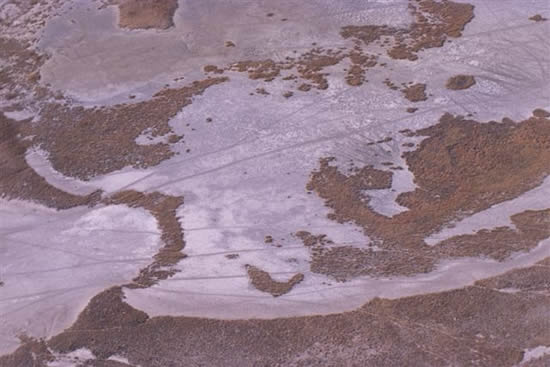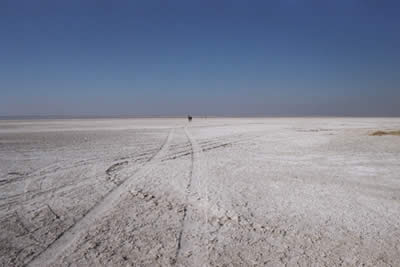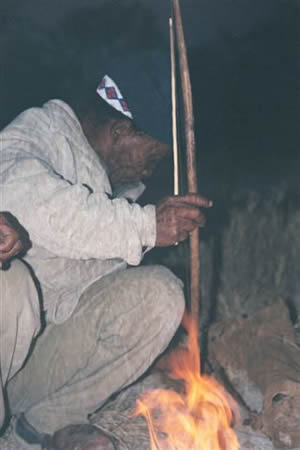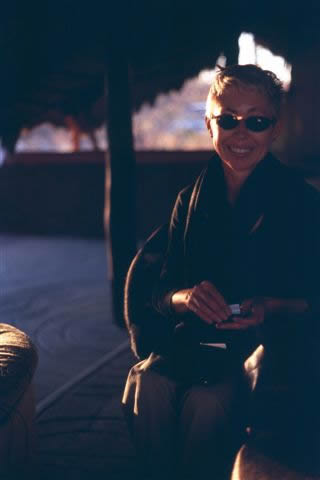Makgadikgadi Pans, Botswana
by Barbara on Jun.05, 2009, under Published Travel Articles
Sunday Independent, Makgadikgadi Pans July 2008
It is early, Joburg is cold, the temperature peaks at -1degrees. I stand outside the airport building, huddle between a wall and a pillar, light a cigarette and feel the wind slice through my thermal vest, my blood drenched heart and wonder ‘will we go’? The hurricane continues unabated, one hour, two ….. we wait and wait, for a hiatus, an exit visa to a promised land. We are going to the Makgadikgadi Pans in Botswana; we are going to the real.
And then we go!
Underneath me, for as far as forever, there are houses and cars and people; toys, mechanical creations. And everything, and everywhere it is all the same.
We touch down in Polokwane, it is warmer, I do not shiver, yet I shake as I hold a pen between thumb and forefinger and fill in the forms, my passport number, 1, 2, 3 … stamped, legitimate travellers. Up again, I concentrate on a map under my hand and the earth below me; a river rises, a mountain peaks, a railroad cuts. I caress a mountain, follow a river with my fingers. Next stop Francistown, another country. We fly over the wide Limpopo River, the border between South Africa, Botswana and Zimbabwe. A border, a random line drawn on a map, and yet the land is the same on the one side as it is the other, arbitrary lines; an imposed meaning on a space.

We stay at Jacks Camp, an unnatural habitat set against the sky. There are ten green stylish canvas tents, colonial and military, an en-suite bathroom and, to dare the sky, an outside shower. I imagine that I am an explorer, Burton … Stanley …. Speke, an explorer in style and comfort. I sleep in a high bed that is covered in an immaculate white cotton feather duvet, copper piping in the bathroom, hand beaten, behind the times paraffin lamps, worn Persian rugs, years of prayer.
The mythology is that while on a trapping expedition in the Pans during the 60’s, Jack Bousfield, came upon this desolate space; wild, striking. It captured his imagination and he set up a camp. This man, this outlaw of Africa, who already held the world record for killing the greatest number of crocodiles, raised his tent under a thorny acacia tree knowing that someday other people would share this space. And other people can share this space, for a price.
Ralph Bousfield, the son of Jack, now owns the lodge. He is tall and tanned. In the cold night he wears a brown leather jacket, by day he wears khaki trousers and a khaki shirt. He blends into nature so well with his tanned skin that never needs sunscreen and his designer dusty camouflage clothing; a privileged accent, a hunting brave voice that takes care of women and small animals.
”My father died about 15 years ago in an aircraft accident,” he says, “and I carry on here. This place was created by my father, that’s him.” Ralph points to a photograph on the wall of the tent; the photograph moves with the wind, black and white, dangerous. A man with a dark grey beard looks down at me; his head is swathed in a kikoi. Next to the photograph is a poster, Peter Beard, Stress and Density, I look at the lissom dark model lean out her hand to feed a giraffe; one more African adventurer, an adventurer who hunted with Hemmingway, wrote a book on the murderous effects of the railroads and discovered the Somalia beauty, Imam.
Jacks Camp, a memorial, a headstone; an honour to the vision of a dead father. It glitters with champagne bubbles; catwalk models rub shoulders with Oprah and Gail, Elton is on his honeymoon, I shake the golden hand. I buy the adventure; I buy the more real than real colours, the stark cold wind and chapped skin; I buy my authenticity.
 Later I take a walk with the Zu/’hoasi Bushmen. An old man who can speak no English walks with a young man. ‘Click clack tick snap ….’ his words are musical, a sign of sound. We walk over dry dust, the young man points out the various plants that bushmen use for medicine, he tells me which are the poison ones that can be used to kill, he shows me a water hole that is never full, it only has water in it as the lodge pumps water to attract the naturally shy, rarely seen, aardwolf a little nearer to the camp, he points to the where the gold yellow full moon will rise and explains how it is used as electricity, a light in the night. After a while they stop. The old man finds two sticks, dry and brittle. He starts to rub the sticks together, then there is a flame, a bright red flame catches the light, the grass begins to burn, smoke curls upwards. The old man lies on his back, the trunk of the Makalali palm tree shadows his face, and he begins to play a sound on the bow of his arrow, melancholy, sad, a lost dead sound, silent. I take out a cigarette and search for the lighter to light it, the young Bushman looks longingly at the cigarette so I take the packet of Camel, I am a ‘camel man’, and offer him one. He takes it.
Later I take a walk with the Zu/’hoasi Bushmen. An old man who can speak no English walks with a young man. ‘Click clack tick snap ….’ his words are musical, a sign of sound. We walk over dry dust, the young man points out the various plants that bushmen use for medicine, he tells me which are the poison ones that can be used to kill, he shows me a water hole that is never full, it only has water in it as the lodge pumps water to attract the naturally shy, rarely seen, aardwolf a little nearer to the camp, he points to the where the gold yellow full moon will rise and explains how it is used as electricity, a light in the night. After a while they stop. The old man finds two sticks, dry and brittle. He starts to rub the sticks together, then there is a flame, a bright red flame catches the light, the grass begins to burn, smoke curls upwards. The old man lies on his back, the trunk of the Makalali palm tree shadows his face, and he begins to play a sound on the bow of his arrow, melancholy, sad, a lost dead sound, silent. I take out a cigarette and search for the lighter to light it, the young Bushman looks longingly at the cigarette so I take the packet of Camel, I am a ‘camel man’, and offer him one. He takes it.
‘Can I use the lighter’ the young man asks me?
I hand it to him, he bends his head, cups his hands around the flame and lights his cigarette. I watch the flicker of the fire in the sand in front of me.
We are driven by Kaelo, a guide, to the edge of the Pans. He is knowledgeable, he is completing a Masters Degree in zoology, an erudite combination of research and guiding. He knows about the geology of the Pans and the reason for the vast upside down umbrella shape of the baobab tree. He stops the vehicle and takes out a geological map; traces it on the salt.
‘This place is a relic of one of the world’s largest super-lakes,’ he says. “It dried up thousands of years ago as a result of the continued shifting of the earth’s crust. When the lake was formed, some five to seven million years ago, its shores were the setting for the growing up of a world, fish, man-ape, dinosaur zebra and hippo….’
We cross the white salt to a known den of the rare brown hyena, not an animal that is often seen, the more common hyena is the spotted version of this carnivore
“This animal has pointed ears and striped legs with a dark brown to black shaggy coat, white shoulders and neck,” Kaelo tells us. “It is different to the spotted hyena, the one that is so well know because of its macabre laugh, the spotted hyena is much bigger, it has a very large head and a sloping back, it is more yellow, has round ears.”
We wait and watch and then quietly, without a whisper or a hint that it will be there, an animal moves from a hole in the salty sand. It has a long cream-coloured mane that seems to extend from the back of its neck and across its shoulder bones.
I watch the animal in the fading twilight; the moonscape, it waits, watching me, wondering, moon shadows of its fur make a mysterious mark on the white salt.
“They are solitary and nocturnal,” Kaelo says, “they lie in thick bush or deserted aardvark burrows during the daytime, which is why we are here now, we would never have seen one in the daylight. This one is part of a clan, they all live in that burrow, watch carefully another may appear, or even one of the young.”
There is a sound in the back of the landrover, the sound of a case being unzipped, the click of a camera lens.
 “I know it is getting dark,” Kaelo turns to the person who has raised a camera, “but you cannot use a flash; it will blind the hyena and scare it, so take a photograph if you want to, but no flash.”
“I know it is getting dark,” Kaelo turns to the person who has raised a camera, “but you cannot use a flash; it will blind the hyena and scare it, so take a photograph if you want to, but no flash.”
“Why didn’t you bring us here earlier,” a complaint, “I want a photograph to prove to the folks back home that I was here and really did see this rare wild animal.”
Early the next morning, after drinking a cup of finely ground coffee that smells perfectly African, the stars still visible and my hands frozen from the cold Kaelo, takes us out again.
“I am going to show you the meerkats,” Kaelo tells all of us who sit on the landrover. We drive for about thirty minutes, stop. Suddenly I notice them; twenty, maybe thirty meerkats are bounding along the earth. They run around, forage, jump, have fun. A lonely sentinel sits on an ant heap, watching, vigilant, a surveillance guard. And yet there may be danger all around this guard and his friends, for we are here, we are watching them.
“Come closer,” Kaelo says to me, “look,” about one meter away from where I stand is a hole. “Shh,” he says, “watch.” From out of the hole a face edges up, big black eyes, then another, then another. “Those are the meerkat babies, the adults keep them in the hole for as long as they can, until they are able to apprehend danger for themselves, and they find food for them until they are strong enough to do this on their own.”
The small meerkats come out of the hole; they show no fear of those that surround them. Across from us two American children, a boy and a girl, stand. “Kneel down,” Kaelo tells them, “in fact one of you stand, the other kneel.” The children obey him. After about five minutes a meerkat approaches and jumps upon the head of the kneeling child, it stands there, on guard, watching. “Stay like that,” Kaelo says quietly, “it will want to get to the highest point, so if you stand and she sits then it will soon jump on your head as you are higher.”
“Take a photograph, quick,” the man calls to his wife, “wow, what a picture to show folks back home.”
“Did Kaelo take you to see the meerkats,” Ralph asks me later? “What did you think, unbelievable hey, so close?”
“I am not so sure about it all,” I reply. “It is not that I did not find them fascinating, beautiful really, and yet I can’t help being concerned that they are so habituated. They are wild animals, and yet they are domesticated, we have made them like us, we discuss their habits in human terms. Is it easy to anthropomorphise for we cannot know how they think, we must assume that they think as we do, comforting, familiar?”
“It’s not that,” Ralph replies, “it is not that we have tamed them, more that they have grown up with people, people are part of their environment. We have never been a predator, we have never invaded their homes, stolen their food, we are here and they are here and so we live together. It is good for both of us.”
People and animals, who, I wonder, is really like whom?
 Outside my tent I face the open space. I want to describe the world that I find around me … to myself, to others, in this piece that I write. I hold the pen above the notebook, the images that come into my head are ones of raw transcendence; colours that are not alienated from the real. How can I describe the olive chocolate spiky grass? I use the word ‘cerulean’ to describe the sky; it sounds exotic, erotic, extravagant. I make the silver salty sand that I taste the flavour of gold in the moonset. I watch the penetrating stars that make up the astrological sign of Scorpio, I watch the past as millions of years have past since the fire burnt out. I describe the almost alive tree with its skeleton thighs, the curve of its bark like stomach, feathery, the sound of the black backed jackal as it calls to a friend. There is no acid yellow or mesmerising scarlet, they are quiet images, natural, earthy. In my reverence for what is before me there is nothing artificial, nothing technologically manufactured, pure and undefiled, part of the Newtonian spectrum.
Outside my tent I face the open space. I want to describe the world that I find around me … to myself, to others, in this piece that I write. I hold the pen above the notebook, the images that come into my head are ones of raw transcendence; colours that are not alienated from the real. How can I describe the olive chocolate spiky grass? I use the word ‘cerulean’ to describe the sky; it sounds exotic, erotic, extravagant. I make the silver salty sand that I taste the flavour of gold in the moonset. I watch the penetrating stars that make up the astrological sign of Scorpio, I watch the past as millions of years have past since the fire burnt out. I describe the almost alive tree with its skeleton thighs, the curve of its bark like stomach, feathery, the sound of the black backed jackal as it calls to a friend. There is no acid yellow or mesmerising scarlet, they are quiet images, natural, earthy. In my reverence for what is before me there is nothing artificial, nothing technologically manufactured, pure and undefiled, part of the Newtonian spectrum.
I am in an untainted space, far away from the world of commoditisation and consumerism, a pristine fantasy; lonely and lonesome. And yet a misgiving creeps in, a silent suspicion. I feel unease as I use a flawless image; a question invades my space: is this the real world, or is this a representation of what the world outside tells me that I must experience, that I must buy? I am reproducing words that represent nothing other than themselves, there is no connection to the space in which I sit, no nexus with essential things, advertising copy. I use extravagant words, I make a fetish of the authentic, a manufactured escalation of my nature lived experience, hyper real, exotic, sensual.
The ghosts of black and white pre history zebra race across the treeless space, they lick the salt, search for water. There is nothing except the moon shadow, the sun set shadow, the shadow of my progress, a hoary silver space. I grasp the fading light, darkness, and salute to somewhere. The shadow of my hand reflects back to me on the salt, it waves good-bye.